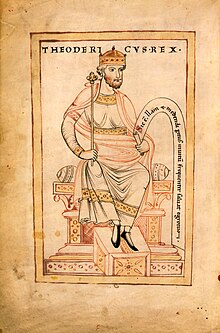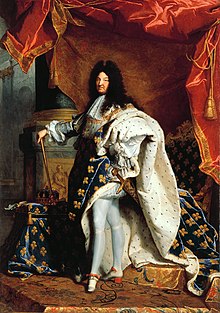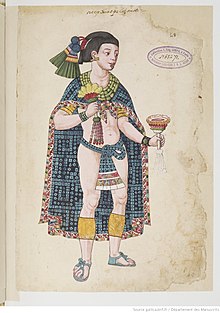राजा
राजा राजतंत्रात्मक शासन तंत्र का सर्वोच्च पद है। प्रायः यह वंशानुगत होता है। कुछ उदाहरण ऐसे जरूर मिलते हैं जहाँ राजा का चुनाव वंश परंपरा के बाहर के लोगों में से किया गया है। वह अपने मंत्रियों की सलाह से अपने राज्य पर शासन करता है। वह अपने शासन क्षेत्र, अधिपत्य या नियंत्रण वाले क्षेत्रों के लोगों के लिए नियम और नीतियाँ बनाता है। उसकी सहायता के लिए दरबार में विभिन्न स्तर के पद होते हैं। राजा के गुण और कर्तव्यों पर महाभारत सहित अनेक ग्रंथों में प्रकाश डाला गया है।
राजा सम्बन्धी भारतीय विचार
राज्य के सप्ताङ्गों का शिरोभाग राजा होता है। शुक्रनीति में कहा गया है-
- सप्ताङ्गमुच्यते राज्यं तत्र मूर्धा नृपः स्मृतः (शुक्रनीति 1/61))।
- (अर्थ - राज्य, सात अंगो वाल होता है। उसमें भी सबसे ऊपर राजा का स्थान है।)
राजारहित इस विश्व में भयाक्रान्त प्राणियों के द्वारा आत्म रक्षार्थ इधर-उधर भ्रमण करने पर, परमात्मा ने इस संसार की रक्षा के लिए इन्द्र, वायु, अष्ट लोकपालों की चिरन्तन शक्ति को संग्रहीत करके उन शक्तियों द्वारा पृथ्वी पालक राजा की सृष्टि की।
- अराजके हि सर्वस्मिन् सर्वतो विद्वते भयात्।
- रक्षार्थमस्य सर्वस्य राजानसृजत् प्रभुः ॥ (शुक्रनीति - 1/71)
- इन्द्रानिलयमार्काणाभग्नेश्च वरूणस्य च ।
- चन्द्राक्तिशयोश्चापि मात्रा निर्हत्य शाश्वतीः ॥ (शुक्रनीति - 1/72)
राज्य की सप्तप्रकृतियों में राजा का स्थान सर्वश्रेष्ठ है। आचार्य चाणक्य ने तो राजा को सप्ताङ्ग राज्य का मूल मानते हुए उसे राज्य ही मान लिया है।
- तत्कूटस्थानीयो हि स्वामीति। राजा राज्यमिति प्रकृतिसंक्षेपः ॥ (कौटिल्य अर्थशास्त्र - 8/1,2)
महाभारत में भी राजा की महत्ता का गुणगान किया गया है।
- राजा प्रजानां प्रथमं शरीरं प्रजाश्च राजोऽप्रतिमं शरीरम् ॥
- राजा विहीना न भवन्ति देशाः, देशैविहीना न नृपा भवन्ति॥ (महाभारत, शान्तिपर्व - 67/59)
भारतीय राजनीतिशास्त्रियों की मान्यता है कि ईश्वर ने अत्याचारियों के भय से डरी हुई प्रजा की रक्षा के लिए इन्द्र, वायु, यम, सूर्य, अग्नि, वरूण, चन्द्रमा तथा कुबेर के अंश से राजा का निर्माण किया है। इस मान्यता का अर्थ है दिव्य शक्तियों के समान राजा भी प्रजा का कल्याण करे, उसकी रक्षा-सुरक्षा करे, उसका लालन-पालन करे।
- ब्राह्मप्राप्तेन संस्कारं क्षत्रियेण यथाविधि।
- सर्वस्यास्य यथान्यायं कर्त्तव्यं परिरक्षणम् ॥ ( मनुस्मृति - 7/2)
- सोऽग्निर्भवति वायुश्च सोऽर्कः सोमः स धर्मराट्।
- सः कुबेरः स वरुणः स महेन्द्रः प्रभावतः ॥' ( मनुस्मृति - 7/7)
- निक्षेप्यस्यसमंमूल्यं दण्डयोनिक्षेपमुक्तथा।
- वस्त्रादिकसभस्तस्य तदाधम्र्मोनहीयते ॥ ( मत्स्यपुराण - 226/1)
- नेच्छत्यन्याधिकारं हि निःस्पृहे मोदते सदा।
- तद्दत्तवस्त्रभूषादिधारकस्तत्पुरोऽनिशम् ॥ ( शुक्रनीति - 2/26)
__LEAD_SECTION__






राजा एक पुरुष सम्राट को विभिन्न संदर्भों में दी गई उपाधि है। महिला समकक्ष रानी है, [1] एक उपाधि जो एक राजा की पत्नी को भी दी जाती है, हालांकि कुछ मामलों में, राजा की उपाधि महिलाओं को दी जाती है जैसे मैरी, हंगरी की रानी के मामले में।
- प्रागितिहास, पुरातनता और समकालीन स्वदेशी लोगों के संदर्भ में, शीर्षक आदिवासी राजशाही का उल्लेख कर सकता है। जर्मनिक राजशाही जनजातीय शासन की भारत-यूरोपीय परंपराओं के साथ संगत है (cf इंडिक राजन, गॉथिक रीक्स और ओल्ड आइरिश री आदि।).
- शास्त्रीय पुरातनता के संदर्भ में, राजा लैटिन में रेक्स के रूप में और ग्रीक में आर्कोन या बेसिलियस के रूप में अनुवाद कर सकता है।
- शास्त्रीय यूरोपीय सामंतवाद में, एक राज्य के शासक के रूप में राजा का शीर्षक सामंती क्रम में सर्वोच्च रैंक समझा जाता है, संभावित विषय, कम से कम नाममात्र, केवल एक सम्राट के लिए ( रोमन गणराज्य के क्लाइंट राजाओं को वापस परेशान करना और रोमन साम्राज्य )। [2]
- एक आधुनिक संदर्भ में, शीर्षक कई आधुनिक राजशाही (या तो पूर्ण या संवैधानिक) में से एक के शासक का उल्लेख कर सकता है। राजाओं के लिए अन्य शीर्षकों के साथ राजा की उपाधि का उपयोग किया जाता है: पश्चिम में, सम्राट, ग्रैंड प्रिंस, राजकुमार, आर्कड्यूक, ड्यूक या ग्रैंड ड्यूक, और इस्लामी दुनिया में, मलिक, सुल्तान, अमीर या हाकिम, आदि। [3]
- एज़्टेक साम्राज्य के शहर-राज्यों में एक टालटोनी था, जो पूर्व-हिस्पैनिक मेसोअमेरिका के राजा थे। ह्युई त्लाटोनी एज़्टेक के सम्राट थे। [4]
शब्द राजा भी एक राजा संघ का उल्लेख कर सकता है, एक उपाधि जो कभी-कभी एक शासक रानी के पति को दी जाती है, लेकिन राजकुमार संघ का शीर्षक अधिक सामान्य है।
__LEAD_SECTION__






राजा एक पुरुष सम्राट को विभिन्न संदर्भों में दी गई उपाधि है। महिला समकक्ष रानी है, [5] एक उपाधि जो एक राजा की पत्नी को भी दी जाती है, हालांकि कुछ मामलों में, राजा की उपाधि महिलाओं को दी जाती है जैसे मैरी, हंगरी की रानी के मामले में।
- प्रागितिहास, पुरातनता और समकालीन स्वदेशी लोगों के संदर्भ में, शीर्षक आदिवासी राजशाही का उल्लेख कर सकता है। जर्मनिक राजशाही जनजातीय शासन की भारत-यूरोपीय परंपराओं के साथ संगत है (cf इंडिक राजन, गॉथिक रीक्स और ओल्ड आइरिश री आदि।).
- शास्त्रीय पुरातनता के संदर्भ में, राजा लैटिन में रेक्स के रूप में और ग्रीक में आर्कोन या बेसिलियस के रूप में अनुवाद कर सकता है।
- शास्त्रीय यूरोपीय सामंतवाद में, एक राज्य के शासक के रूप में राजा का शीर्षक सामंती क्रम में सर्वोच्च रैंक समझा जाता है, संभावित विषय, कम से कम नाममात्र, केवल एक सम्राट के लिए ( रोमन गणराज्य के क्लाइंट राजाओं को वापस परेशान करना और रोमन साम्राज्य )। [6]
- एक आधुनिक संदर्भ में, शीर्षक कई आधुनिक राजशाही (या तो पूर्ण या संवैधानिक) में से एक के शासक का उल्लेख कर सकता है। राजाओं के लिए अन्य शीर्षकों के साथ राजा की उपाधि का उपयोग किया जाता है: पश्चिम में, सम्राट, ग्रैंड प्रिंस, राजकुमार, आर्कड्यूक, ड्यूक या ग्रैंड ड्यूक, और इस्लामी दुनिया में, मलिक, सुल्तान, अमीर या हाकिम, आदि। [3]
- एज़्टेक साम्राज्य के शहर-राज्यों में एक टालटोनी था, जो पूर्व-हिस्पैनिक मेसोअमेरिका के राजा थे। ह्युई त्लाटोनी एज़्टेक के सम्राट थे। [7]
शब्द राजा भी एक राजा संघ का उल्लेख कर सकता है, एक उपाधि जो कभी-कभी एक शासक रानी के पति को दी जाती है, लेकिन राजकुमार संघ का शीर्षक अधिक सामान्य है।
इन्हें भी देखें
- ↑ There have been rare exceptions, most notably Jadwiga of Poland and Mary, Queen of Hungary, who were crowned as King of Poland and King of Hungary respectively during the 1380s.
- ↑ The notion of a king being below an emperor in the feudal order, just as a duke is the rank below a king, is more theoretical than historical. The only kingdom title held within the Holy Roman Empire was the Kingdom of Bohemia, with the Kingdoms of Germany, Italy and Burgundy/Arles being nominal realms. The titles of King of the Germans and King of the Romans were non-landed titles held by the Emperor-elect (sometimes during the lifetime of the previous Emperor, sometimes not), although there were anti-Kings at various points; Arles and Italy were either held directly by the Emperor or not at all. The Austrian and Austro-Hungarian Empires technically contained various kingdoms (Hungary, Bohemia, Dalmatia, Illyria, Lombardy–Venetia and Galicia and Lodomeria, as well as the Kingdoms of Croatia and Slavonia which were themselves subordinate titles to the Hungarian Kingdom and which were merged as Croatia-Slavonia in 1868), but the emperor and the respective kings were the same person. The Russian Empire did not include any kingdoms. The short-lived First French Empire (1804–1814/5) included a number of client kingdoms under Napoleon I, such as the Kingdom of Italy, the Kingdom of Westphalia, the Kingdom of Etruria, the Kingdom of Württemberg, the Kingdom of Bavaria, the Kingdom of Saxony and the Kingdom of Holland. The German Empire (1871-1918) included the Kingdoms of Prussia, Bavaria, Württemberg and Saxony, with the Prussian king also holding the Imperial title.
- ↑ अ आ Pine, L.G. (1992). Titles: How the King became His Majesty. New York: Barnes & Noble. पृ॰ 86. आई॰ऍस॰बी॰ऍन॰ 978-1-56619-085-5.Pine, L.G. (1992). Titles: How the King became His Majesty. New York: Barnes & Noble. p. 86. ISBN 978-1-56619-085-5.
- ↑ History Crunch Writers. "Aztec Emperors (Huey Tlatoani)". History Crunch - History Articles, Summaries, Biographies, Resources and More (अंग्रेज़ी में). अभिगमन तिथि 18 April 2021.History Crunch Writers. "Aztec Emperors (Huey Tlatoani)". History Crunch - History Articles, Summaries, Biographies, Resources and More. Retrieved 18 April 2021.
- ↑ There have been rare exceptions, most notably Jadwiga of Poland and Mary, Queen of Hungary, who were crowned as King of Poland and King of Hungary respectively during the 1380s.
- ↑ The notion of a king being below an emperor in the feudal order, just as a duke is the rank below a king, is more theoretical than historical. The only kingdom title held within the Holy Roman Empire was the Kingdom of Bohemia, with the Kingdoms of Germany, Italy and Burgundy/Arles being nominal realms. The titles of King of the Germans and King of the Romans were non-landed titles held by the Emperor-elect (sometimes during the lifetime of the previous Emperor, sometimes not), although there were anti-Kings at various points; Arles and Italy were either held directly by the Emperor or not at all. The Austrian and Austro-Hungarian Empires technically contained various kingdoms (Hungary, Bohemia, Dalmatia, Illyria, Lombardy–Venetia and Galicia and Lodomeria, as well as the Kingdoms of Croatia and Slavonia which were themselves subordinate titles to the Hungarian Kingdom and which were merged as Croatia-Slavonia in 1868), but the emperor and the respective kings were the same person. The Russian Empire did not include any kingdoms. The short-lived First French Empire (1804–1814/5) included a number of client kingdoms under Napoleon I, such as the Kingdom of Italy, the Kingdom of Westphalia, the Kingdom of Etruria, the Kingdom of Württemberg, the Kingdom of Bavaria, the Kingdom of Saxony and the Kingdom of Holland. The German Empire (1871-1918) included the Kingdoms of Prussia, Bavaria, Württemberg and Saxony, with the Prussian king also holding the Imperial title.
- ↑ History Crunch Writers. "Aztec Emperors (Huey Tlatoani)". History Crunch - History Articles, Summaries, Biographies, Resources and More (अंग्रेज़ी में). अभिगमन तिथि 18 April 2021.History Crunch Writers. "Aztec Emperors (Huey Tlatoani)". History Crunch - History Articles, Summaries, Biographies, Resources and More. Retrieved 18 April 2021.